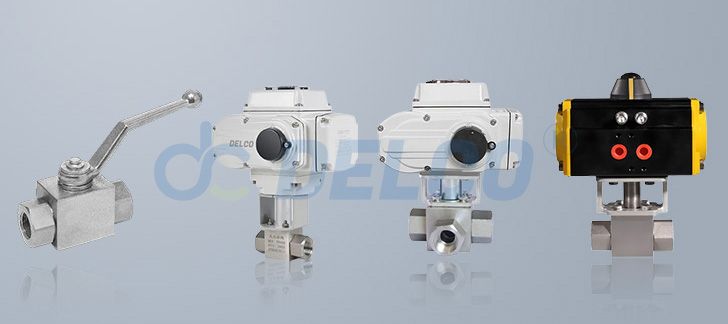المدونة
توفر شركة ديلكو للصمامات حلولاً متنوعة ومثالية للصمامات الصناعية، خاصة لصمامات التحكم.
- الصفحة الرئيسية
- "
- المدونة
- "
- صمام الكرة عالي الضغط: دليل شامل
العلامات
اتصل بنا
صمام الكرة عالي الضغط: دليل شامل
- صمام ديلكو
High-pressure ball valves are valves whose opening and closing parts are driven by the valve stem and rotate around the axis of the valve stem. Used in hydraulic machinery and equipment, hydraulic switch, natural gas and so on. With the rapid development of science and technology and the continuous improvement of product structure, high-pressure ball valves have rapidly developed into a major category of valves.
What are high-pressure ball valves
High-pressure ball valves are designed with a central aperture ball that rotates a quarter turn or 90 degrees to control fluid flow. The valve is open when the hole on the ball is in line with the direction of fluid flow. High-pressure ball valves are robust, enduring high pressures and temperatures, crafted from durable metallic materials like stainless steel. They maintain quality through repeated use and are available with compression, threaded, or bolted nut connections.
Components of high-pressure ball valves
Body: The body contains all internal components of the valve. It is typically made of robust materials like stainless steel, carbon steel, and other strong metallic materials.
Stem: The stem connects the actuator or handwheel to the ball to improve fluid flow control. It is made of durable material to transmit opening and closing torque, allowing it to function effectively in high-pressure and high-temperature environments.
Seats : The seats are internal components reinforced with a seat ring to keep the valve leak-free. Seats can be metal or made of other materials such as elastomer.
Ball : The ball is usually made of a strong material such as steel and control the flow of fluid by blocking or allowing it to enter the valve. The surface of the ball is perforated to ensure even pressure distribution. High-pressure ball valves can feature a reduced-bore ball for applications requiring reduced flow pressure or a full-bore ball for unrestricted fluid flow.
Actuator : High pressure ball valves are actuated and closed by manual, electric or pneumatic actuators. Manual actuators are controlled by the valve operator, while electric and pneumatic actuators are used in high pressure situations where automation is possible.
Trim: Trim in high-pressure ball valves comprises replaceable or removable elements that come into contact with the fluid flow. These components consist of the stem, seating surfaces, ball, and seals.
How high-pressure ball valves work
To operate a high-pressure ball valve, turn the actuator or handwheel 90 degrees to rotate the attached stem. The stem rotates the ball inside the valve. The rotation aligns the hollow side of the ball with the piping, thereby opening the flow of fluid. Rotating the actuator another 90 degrees stops fluid flow by aligning the hollow side of the ball perpendicular to the pipe. Fluid pressure creates a tight seal between the seat and ball, stopping fluid flow.
Actuators used in high-pressure ball valves
- Manual Actuators: Operated by hand via a handwheel
- المشغلات الهوائية: Operated via compressed air
- المشغلات الكهربائية: Operated via electric motor
- Hydraulic Actuators: Operated via pressurized fluid such as oil and water
Advantages of high-pressure ball valves
- Simple structure: Compact size, lightweight
- High strength: Resistant to high temperature, corrosion and wear
- Low fluid resistance: Full-bore ball valves have minimal flow resistance
- Good sealing performance: Two sealing surfaces can achieve complete sealing
- Convenient operation: Quick opening/closing with 90° rotation, suitable for remote control
- Easy maintenance: Simple structure,generally uses movable sealing ring, easy disassembly and replacement
- Wide range of applications: Diameters range from a few millimeters to several meters, and can be used from high vacuum to high pressure
Applications of high-pressure ball valves
- Petrochemical industry: High-pressure ball valves are widely uesd in the petrochemical industry for regulating the flow of crude oil, natural gas, and chemical products
- Power industry: High-pressure ball valves are essential in the power industry for controlling natural gas pipelines, boiler feed water and steam turbine systems
- Chemical industry: High-pressure ball valves are widely used and suitable for stable operation of various chemical media such as ammonia and polymers
- Mining and metallurgical industry: High pressure ball valves play an important role in the control of fluids and the safe handling of ores and tailings in mining and metallurgy
- Urban water supply and drainage systems: High-pressure ball valves are essential for controlling flow, pressure and rapid response to sudden demands in urban water supply and drainage systems
الخاتمة
In conclusion, high-pressure ball valves play a crucial role in various industries such as petrochemical, power generation, chemical, mining, and urban water systems. high-pressure ball valves driven by durable metallic materials and efficient design, offer a reliable solution for controlling fluid flow in high-pressure and high-temperature environments. With their simple structure, strong sealing performance, and ease of maintenance, high-pressure ball valves provide a versatile and effective means of fluid control across a wide range of applications. Their resilience to harsh conditions, coupled with their ability to ensure precise flow control, underlines their significance in ensuring the safe and efficient operation of diverse systems.


